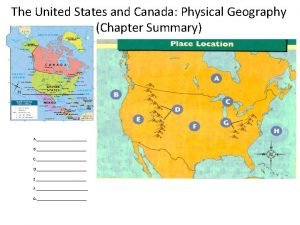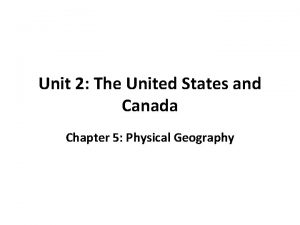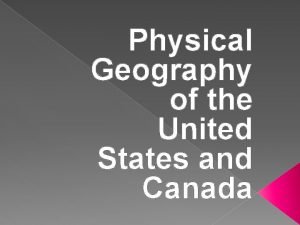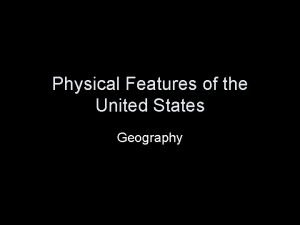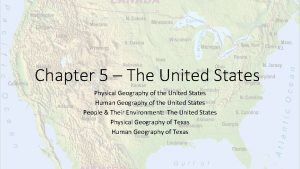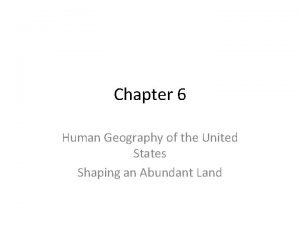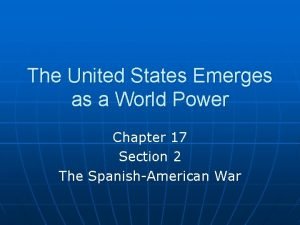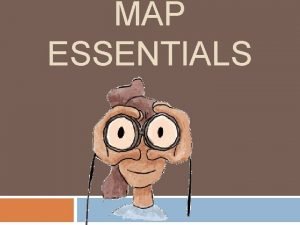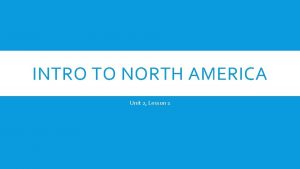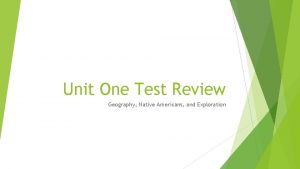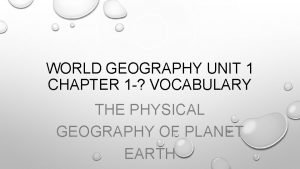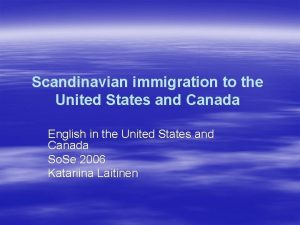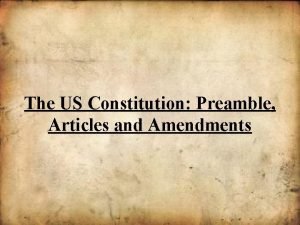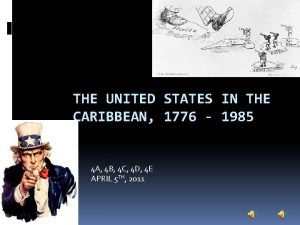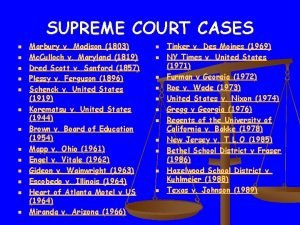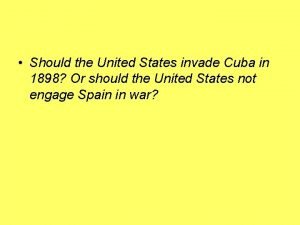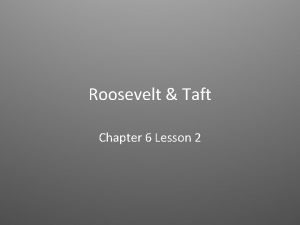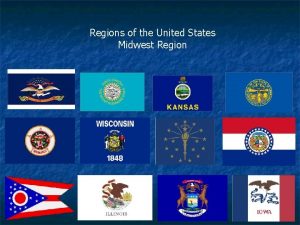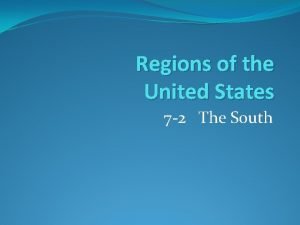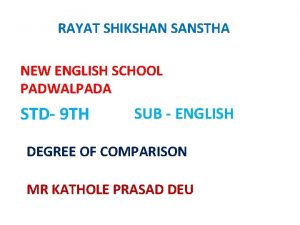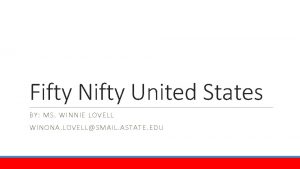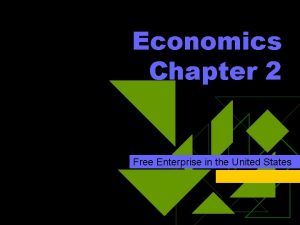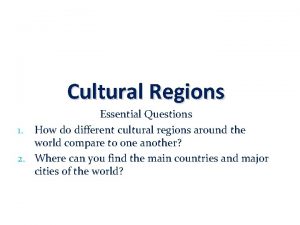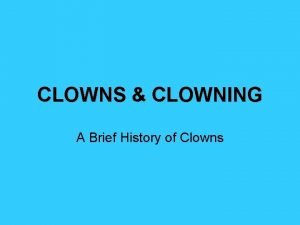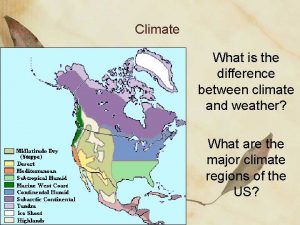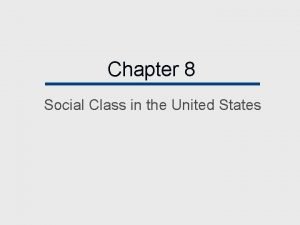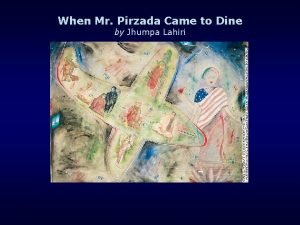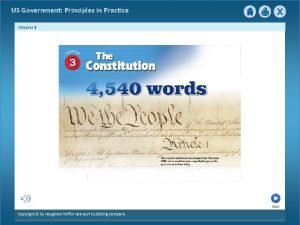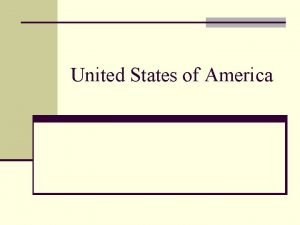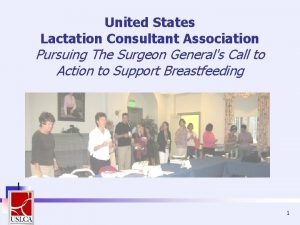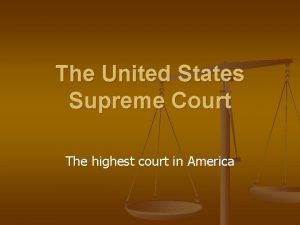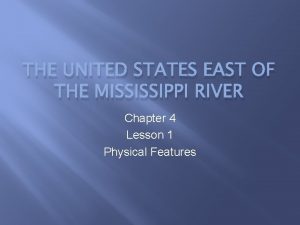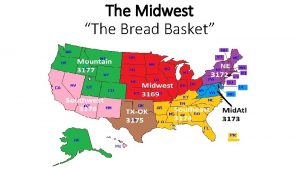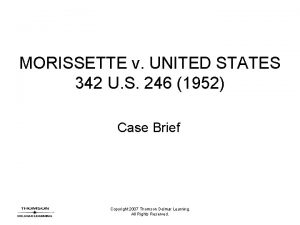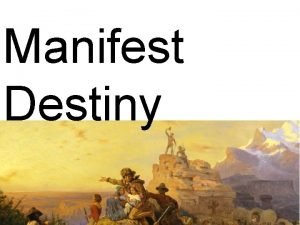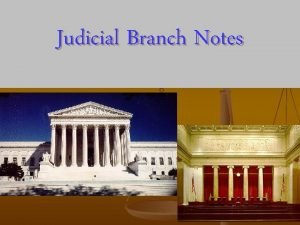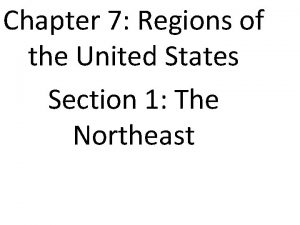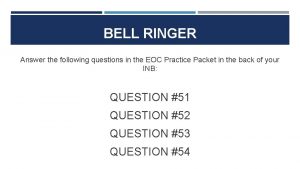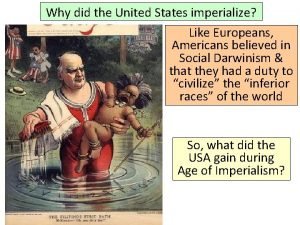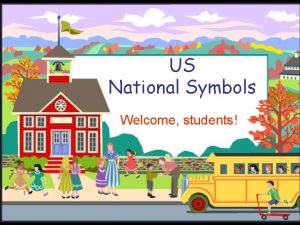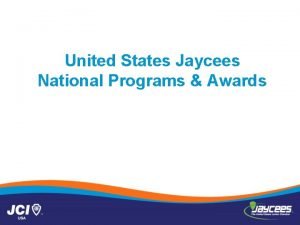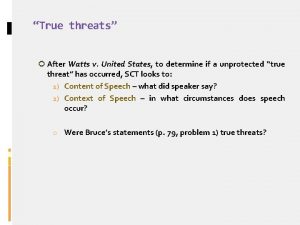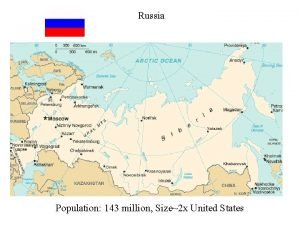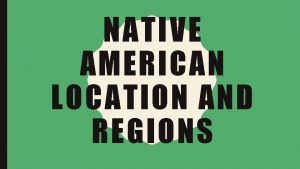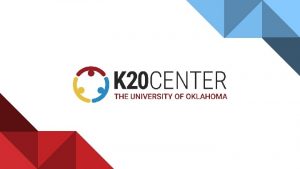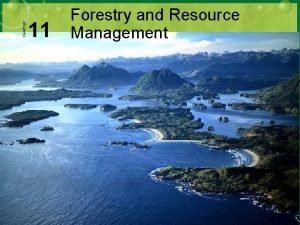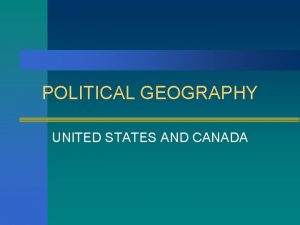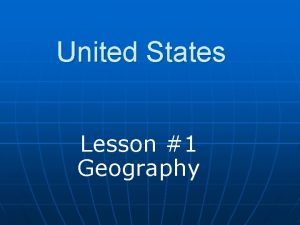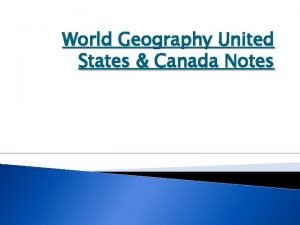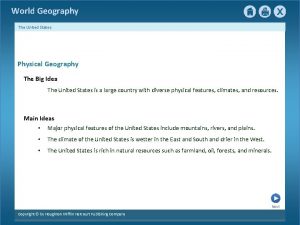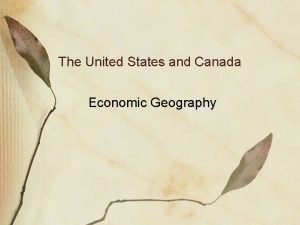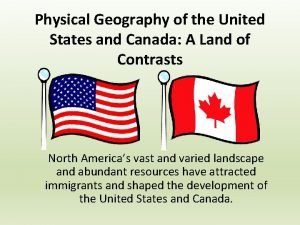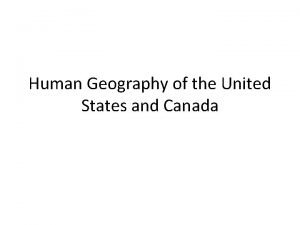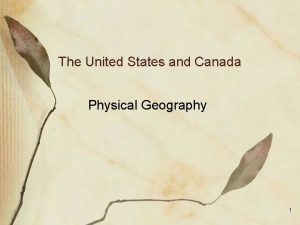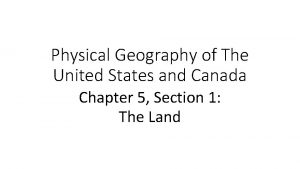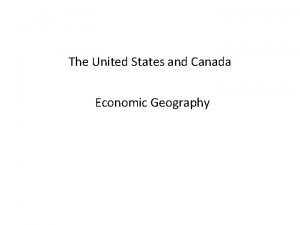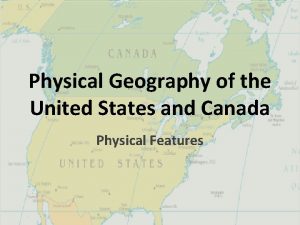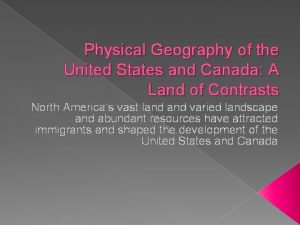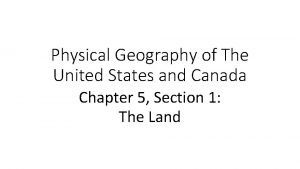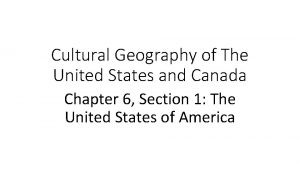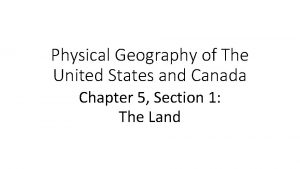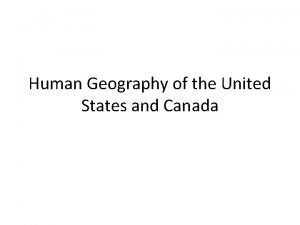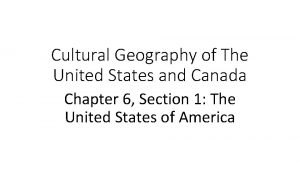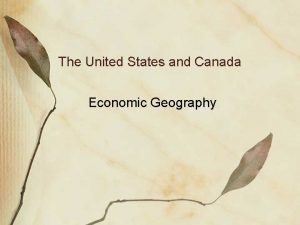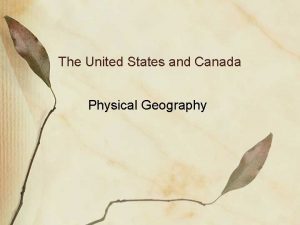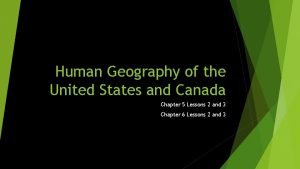World Geography Unit 2 United States and Canada




































































- Slides: 68

World Geography Unit 2: United States and Canada Spring 2009

Location of major physical features ► Rocky Mountains ► ___________ ► Pacific Mountain Ranges ► Pacific, Atlantic, and Arctic Oceans ► Gulf of Mexico ► Great Plains ► ___________

Subregions ► Subregions of the § ______________ United States ► Subregions of Canada § ________________ Provinces § ___________________


Subregions of United States ► Northeast: • New England —six _____ states of Northeast: ► -Maine, Vermont, New Hampshire, Mass. , Rhode Island, Connecticut • _________ states: Pennsylvania, New York, New Jersey • Northeast has only ______of land, but _____ of population

Northeast ► Europeans settled here first; region served as _________ ► Northeast was, and is, U. S. heart of trade, commerce, industry - Philadelphia, Boston, New York City: international trade centers - U. S. industrialization fueled by Pennsylvania coal, iron ore, oil

Northeast ► Today most people are employed in __________________ ► ____ farmland in Pennsylvania, New York, New Jersey ► New England too hilly, rocky for much agriculture ► “_______”: some Mid-Atlantic industry declined, moved south, west

NE: Growth of the Megalopolis • Megalopolis— __________________ - “______: ” Boston, New York City, Philadelphia, Washington, D. C. - 500 miles; ______ of U. S. population; connected by road, rail, air links


Midwest Region

Region: the Midwest ► The Midwest —north-central U. S. , known as the ______________ - ______ of U. S. land, _____of population - early settlers came from Britain, Germany, Scandinavia

Midwest ► Agricultural and Industrial Heartland • Central location, soil, climate make it nation’s “_________” - corn, wheat, soy beans, meat, dairy; meatpacking, food-processing • Trade, distribution on ___________, with _______ as hub - cities near Great Lakes: Chicago, Cleveland, Detroit, Milwaukee - on rivers: Cincinnati, St. Louis, Minneapolis/St. Paul, Omaha

Midwest ► Changing • • • Face of the Midwest Farm numbers ______, more people working in service industries ___________ areas expand as people leave cities for suburbs People and industries moving to _______________

Map of the South Region

Region: The South ► The Region • The South — _______ of U. S. land, more than ______ of population - 11 states were once part of the Civil War Confederacy - Texas was in Confederacy, sometimes considered part of ________

The South ► The • • • Old South _______` was England’s first American colony South’s ethnic mix includes Africans, Hispanics, Cajuns, Creoles Once agricultural, _____; now rapidly changing, _____ growing

The South ► • • • The New South Agriculture: cotton, tobacco, fruits, peanuts, rice, livestock Energy resources and air conditioning boost industry in 1950 s “_______” attracts _________________________ industries: petroleum, steel, chemicals, textiles, electronics _________ —large cities and nearby suburbs, towns Atlanta (hub); Miami, New Orleans, Houston, Dallas, San Antonio

The West

Region: The West ► The Region • The West —from Great Plains to Pacific, plus Alaska and Hawaii - _______ of U. S. land, ____ of population - people settle where climate and landforms are most ________

The West Developing the West • California is most populous state - __________ the West’s cultural, commercial center • Rapid 20 th-century growth due to __________, irrigation - Colorado River water diverted to Las Vegas, Tucson, Phoenix • Economy: foreign trade with Asia; varied industries - farms, ranches, logging, fish, mines, oil, tourism, film, computers

Subregions of Canada

Subregions of Canada: Atlantic Provinces ► Harsh • • • Lands and Small Populations Eastern Canada’s Atlantic Provinces: - Prince Edward Island, New Brunswick, Nova Scotia, Newfoundland Only ______ of Canada’s population, due to ______ terrain, _____harsh weather Most people live in ______ cities such as: - Halifax, Nova Scotia - St. John, New Brunswick

The Core Provinces— Quebec and Ontario ► The • • Heartland of Canada Quebec City: French explorer Samuel de Champlain built fort in 1608 _______ Canada’s population live in Core Provinces Ontario and Quebec - Ontario has __________; Quebec has the __________

Quebec and Ontario ► Canada’s • • Political and Economic Center _____, Ontario is the national capital ______ has great political importance in French-Canadian life Core: 35% of Canada’s crops, 45% of minerals, 70% of manufacturing ______ the largest city, finance hub; ______ second largest city

The Prairie Provinces ► Canada’s • • ________ Great Plains Prairie Provinces: Manitoba, Saskatchewan, Alberta 50% of Canada’s agricultural production, 60% of mineral output - Alberta has ______, ______ deposits; produces 90% of Canada’s _______

The Pacific Province and the Territories ► British • • • - Columbia British Columbia —__________, mostly in ______ Mountains -_______ is forests; _______ is frozen tundra, snowfields, glaciers Most people live in _______; -major cities are Victoria, Vancouver Economy built on logging, mining, hydroelectric power Vancouver is Canada’s largest port, has a prosperous shipping trade

Northwest Territories ► • • • The Territories The ____________________ account for 41% of Canada’s land Sparsely populated due to rugged land severe climate _______ has population of 30, 000; mostly wilderness ____________ has population of 41, 000; extends into _______ was created from Northwest Territories in ____; home to _____. Territories’ economies include mining, fishing, some logging

Nunavut Territory and the Inuit

What are the major Climates of US and Canada ► Tundra ► Subarctic ► Highland ► Humid Continental ► Marine West Coast ► Humid Subtropical ► Mediterranean ► Semiarid ► Desert ► Tropical Wet and Dry



Describe the major climates of Canada and United States ► Colder Climates § Tundra: ___________________ ► Long bitterly ______ winters ► Short and chilly summers (av. High ______° F. ) ► __________ § Subarctic: ______ climate of Alaska and Canada ► ____ winters/short _______ summers ► Evergreen forest § Highland: _____ Mountains and ____ Ranges ► Temperatures and Vegetation vary with elevation ► Why? § What is Permafrost?

► Moderate Climates § Humid Continental: N. Central NE U. S. and Southern Canada ► ____ winters/ ______ summers ► __________ ► Most of Canadian population resides in this climate ► In U. S. , deciduous forests lie east of Miss. River ► In U. S. , temperate grasslands west of Miss. River § Marine West Coast: Pacific Coast-N. CA S. AK ► Summers _____/winters ______ ► Climate influenced by ______________, and prevailing westerlies § Prevailing westerlies: winds that blow west to east

► Mild Climates § Humid Subtropical: most _____states ►________ summer/ mild _______ winters ►________ § Mediterranean: Central and South CA coast ►_______ sunny summers ►Mild ____ winters ►Temperatures range from 50° to 80° year round

► Dry Climates § Semiarid: Great Plains, northern Great Basin ► ______weather, ______rainfall/yr § Desert: Southwestern States ► ___________ weather, ______rainfall/yr ► Mojave and Sonoran deserts ► Tropical Climates § Tropical Wet: HI ► Mount Waialeale on Kauai Island is one of the wettest spots on earth. Av. annual rainfall: _______rainfall/yr ► Temperatures in 70 s § Tropical Wet/Dry: Southern FL ► Distinct Wet/Dry seasons ► __________

How do major climates affect the United States and Canada Weather-influenced by Climate Map page 106 • Warm Gulf air clashes with cold Canadian air over the Great Plains - creates ________________ • ________ sweep the Gulf and Atlantic coasts in summer and fall • Heavy rains cause _____ along big rivers like the Mississippi • Heat, lack of rain bring ______, dust storms, forest fires

Hurricanes

Tornados and Thunderstorms


Drought .

How else do major climates impact the United States and Canada? ► Settlement patterns § i. e. sunbelt Industry --Agriculture --Tourism

http: //www. usgcrp. gov/usgcrp/Library/nationalassessment/overview. Changing. Nation. htm

► Population Density of the US and Canada ► Use map on page 107 to answer these questions § Which area has the lowest population density? ► How can you tell it has the lowest density? ► Why does the SW have the lowest population density? § In what area of the US is the population density the highest? § What do the cities in the area with the highest population density all have in common? § What other areas have high population densities? ► Why are the populations higher in these specific areas? § What is the population density of Atlanta? Edmonton? New York?

Reasons for Population Distribution in Canada and the United States ► Why is most of Canada’s population along the border with the US? ► Consider § Climate and Topography § Bodies of Water § Settlement patterns


Why people live where they live People settle in regions for various reasons -i. e. land/resources, climate Therefore, physical geography can lead to regional growth and development Rich and abundant soils encouraged ___________ travel to Midwest. _________deposits helped the Northeast develop __________

Look at Natural Resources Map on page 120 What information can we get from this map? ► Does this map help explain location of industry? ► § Why or why not? ► Is the information useful when determining population distribution? § Why or why not? § Also think historically!

Look at the map on pg 106 and answer the questions in your notes ► Page 106 top map: Canada-US connections § Look at Canada-US Connections ►What does this map show? ►What can we decipher from this map?

Look at map on page 106 and answer questions in your notes ► Economic activities of the US Canada § What is Canada’s most wide spread economic activity? US econ activity? § Why is (forestry/hunt/fish or commercial farming) the most prevalent econ activity? § Near what bodies of water do commercial fishermen live? ► Oceans ► What about great lakes? § Around which body of water does a great deal of US manufacturing occur? § Where are manufacturing and trade concentrated in the US and Canada?

Shaping An Abundant Land ► The United States: - occupies _____ of North America - world’s ____ largest country in land area, population • Rich resources and moderate climate have always attracted immigrants - constant ______—movement—of peoples within the country

We’re Coming to America ► Nomads § ________ ► Spanish § ________ ► French § ________ ► English § ________

Columbian Exchange The _______ of plants, animals, and diseases between the Eastern and Western Hemispheres during the ___________ See chart page 136 To Old World (Europe) tomatoes, corn, turkeys, _________… To New World (Americas) cattle, bananas, peaches, _________…

Becoming a Nation ► __________ War ► Soon after becoming a nation, America began growing in size.

The United States practically doubled in size with the Louisiana Purchase of 1803. ► Rich, fertile lands ► Helped spur westward migration. ►

Development of Transportation ► Westward movement helped lead to development of transportation. § § § Wagon trains _____________ No more frontier by 1900. ► Development of the _________ § Led to roads, and eventually ________ ► Transportation and Industrialization go “hand in hand” -How is this statement based on Geography?

How transportation improvements lead to the growth of industry? ► movement of goods and materials § _____ ►_________. Must have access to water. § by river (i. e. Mississippi/St Lawrence) § Ocean (i. e. Port of Savannah) § ______ ►Do not have to be located on water ►Opened up more land for industrialization

Canals and Water Transport: How do canals work? How are canals beneficial? --Industry

Transportation and the Growth of Industry ► Able to transport and sell goods and resources ► Companies and Individuals _____ money earned § _______ business § Produce more product(s)/ ►Research and develop new products § Build _______ facilities § Employ _______ workers

Consequences of transportation and communication growth ► _________: Poorly planned development that spreads a city’s population over a wider and wider geographic area. ► How did automobiles encourage sprawl? ► What are the environmental impacts of urban sprawl?

Solutions to Urban Sprawl ► Many cities developing plans for smart growth ► ________ is the efficient use and conservation of land other resources ► Another solution is __________ ► Definition: a community where residents can live and work in harmony with the environment ►What does this definition mean? ►How will this help ease the problems associated with Urban Sprawl?

Sprawl ► What American city has the most sprawl? ► Write your answer down and explain why. § And the answer is. . . ►http: //sprawlcity. org ► Visual found at ►http: //envplan 240. pbwiki. com/Urban+Sprawl

Look at this cartoon. ► Describe what you see. ► What point is the artist trying to make? ► Does this cartoon help you understand urban sprawl? ►

Write this in your agenda ► Homework Due tomorrow § Find and print a cartoon depicting Urban Sprawl § Write in paragraph form ►Describe the cartoon. § i. e. three men are talking about the future encroachment of Megalopolis. Only one man is going to work in the city. Etc. ►What is the main point? § The main point is… Support your reasoning § Staple cartoon to your paper. § This is a graded assignment, please do your best!

People of the US and Canada ► United § § States Population: ____ Million _____% live in city/suburb ► Where do the majority of Americans have their ethnic roots? § Which Continent? § Which Countries? ► Languages… ► Canada § Population: ____ Million (2007 est. ) § _____% live on ____ of land § Along 100 mile _____ with US ► Where do a majority of Canadians have their ethnic roots? ► Languages…

Religious Groups in the US ► There are more than _____ religious groups in the United States ► Largest group is Christians (approx ____%) § Why do you think Christians make up the majority of the American population? § 2% Jewish, § 2% Muslim, § 11% other

Religious Customs and Traditions ► What are some major customs and traditions of these religious groups? ► Write them in your notes

Religious Groups in Canada ► _____ Protestant ► _____ Catholic ► Increasing number of Jewish, Muslim, and other groups immigrating to Canada.

Ethnic groups in US Turn to page 142 and look at Maps: -- Which subregion has the highest concentration of African-Americans? Why? -- Hispanics? Why? -- Native Americans? Why? Complete the Skillbuilder Questions in your notes
 Slidetodoc.com
Slidetodoc.com Mediterranean climate in us
Mediterranean climate in us Unit 2 the united states and canada worksheet answers
Unit 2 the united states and canada worksheet answers United states and canada physical map
United states and canada physical map What are the major physical features of the united states
What are the major physical features of the united states Physical geography of the united states
Physical geography of the united states Chapter 6 human geography of the united states
Chapter 6 human geography of the united states States west of the mississippi
States west of the mississippi The united states emerges as a world power
The united states emerges as a world power Awake united states
Awake united states Map of world with longitude and latitude lines
Map of world with longitude and latitude lines Us history regents essay
Us history regents essay Economics unit 2 lesson 1
Economics unit 2 lesson 1 World geography unit 1 test
World geography unit 1 test World geography unit 1 vocabulary
World geography unit 1 vocabulary How many states canada
How many states canada Was the united states on the axis powers or allied powers?
Was the united states on the axis powers or allied powers? 36 30 line
36 30 line Usa pro soccer
Usa pro soccer United states v. nixon significance
United states v. nixon significance United states student association
United states student association The united states ought to provide a universal basic income
The united states ought to provide a universal basic income Constitution preamble
Constitution preamble The united states in the caribbean 1776 to 1985
The united states in the caribbean 1776 to 1985 Southeast region physical features
Southeast region physical features Expansion of the united states of america 1607 to 1853 map
Expansion of the united states of america 1607 to 1853 map Why did truman believe greece needed aid
Why did truman believe greece needed aid Original united states previous owner
Original united states previous owner Mapp v. ohio
Mapp v. ohio Why did the united states invade cuba in 1898?
Why did the united states invade cuba in 1898? Lesson 2 roosevelt and taft
Lesson 2 roosevelt and taft Midwest region of the united states
Midwest region of the united states 7 regions of the united states
7 regions of the united states The united states is the greatest buyer positive degree
The united states is the greatest buyer positive degree Fifty united states
Fifty united states Chapter 2 free enterprise in the united states
Chapter 2 free enterprise in the united states North central america
North central america Grotesque whiteface
Grotesque whiteface Subtropical united states
Subtropical united states What are the social classes in the united states
What are the social classes in the united states Ibn-tamas v. united states
Ibn-tamas v. united states Mr pirzada came to dine theme
Mr pirzada came to dine theme United states government principles in practice
United states government principles in practice Geographical position of the usa
Geographical position of the usa United states lactation consultant association
United states lactation consultant association What is the highest court in the united states? *
What is the highest court in the united states? * Which states are east of the mississippi river
Which states are east of the mississippi river Bread basket state
Bread basket state United states v. cruikshank apush
United states v. cruikshank apush Morisette v united states
Morisette v united states What did manifest destiny do
What did manifest destiny do Judicial branch
Judicial branch Fifty nifty united states from thirteen original colonies
Fifty nifty united states from thirteen original colonies What are the 7 regions of the united states?
What are the 7 regions of the united states? Bell ringer response sheet
Bell ringer response sheet Why did the united states imperialize
Why did the united states imperialize U.s. national symbols
U.s. national symbols United states jaycees
United states jaycees Uscdi
Uscdi Fort bragg population pyramid
Fort bragg population pyramid Watts v. united states
Watts v. united states Polovtsian
Polovtsian Native american tribes in the united states
Native american tribes in the united states Salad bowl model of diversity
Salad bowl model of diversity Activity 2 let's review
Activity 2 let's review United states collectivism
United states collectivism In the united states, most logging takes place in ________.
In the united states, most logging takes place in ________. United states bicycle route system
United states bicycle route system What is the current intraregional migration trend in the us
What is the current intraregional migration trend in the us
